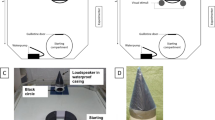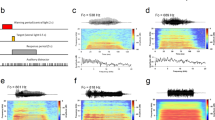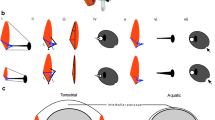Abstract
Gentry and Peterson1 have compared data obtained from a sea otter (Enhydra lutris) on an underwater size discrimination task with data obtained by Schusterman et al.2 using two sea lions (Zalophus californianus). Although Gentry and Peterson did not test the sea otter's vision in air, they concluded that its performance was inferior to that of the sea lion because the “pinniped eye” is emmetropic underwater with adaptations for aerial vision and that the “otter eye” (Lutra) was emmetropic in air with adaptations for underwater vision3. Such an interpretation of the difference between otters and sea lions emphasizes different dioptric mechanisms and ignores neural structure and organization at the retinal level, as well as at the level of the cortical projection areas.
This is a preview of subscription content, access via your institution
Access options
Subscribe to this journal
Receive 51 print issues and online access
$199.00 per year
only $3.90 per issue
Buy this article
- Purchase on Springer Link
- Instant access to full article PDF
Prices may be subject to local taxes which are calculated during checkout
Similar content being viewed by others
References
Gentry, R. L., and Peterson, R. S., Nature, 216, 435 (1967).
Schusterman, R. J., Kellogg, W. N., and Rice, C. E., Science, 147, 1594 (1965).
Walls, G. L., The Vertebrate Eye (Hafner, New York, 1963).
Landau, D., and Dawson, W. W., Vision Res., 10, 691 (1970).
Schusterman, R. J., and Balliet, R. F., Science, 169, 498 (1970).
Neumann, F., and Schmidt, H. D., Z. Vgl. Physiol., 42, 199 (1959); as cited in Rahmann, H., Naturw. Rdsch. Stuttg., 20, 8 (1967).
Harris, C. J., Otters: A Study of the Recent Lutrinae (Weidenfeld and Nicolson, London, 1968).
Schusterman, R. J., in The Behavior and Physiology of Pinnipeds (edit. by Harrison, R. J., Hubbard, R. C., Peterson, R. S., Rice, C. E., and Schusterman, R. J.) (Appleton-Century-Crofts, New York, 1968).
Schusterman, R. J., and Balliet, R. F., Nature, 226, 563 (1970).
Harrison, R. J., and King, J. E., Marine Mammals (Hutchinson, London, 1965).
Author information
Authors and Affiliations
Rights and permissions
About this article
Cite this article
BALLIET, R., SCHUSTERMAN, R. Underwater and Aerial Visual Acuity in the Asian “Clawless” Otter (Amblonyx cineria cineria). Nature 234, 305–306 (1971). https://doi.org/10.1038/234305a0
Received:
Revised:
Issue Date:
DOI: https://doi.org/10.1038/234305a0
This article is cited by
-
Adaptations for amphibious vision in sea otters (Enhydra lutris): structural and functional observations
Journal of Comparative Physiology A (2020)
-
Amphibious Nature of Visual Acuity in the Asian “Clawless” Otter
Nature (1973)
Comments
By submitting a comment you agree to abide by our Terms and Community Guidelines. If you find something abusive or that does not comply with our terms or guidelines please flag it as inappropriate.



